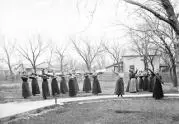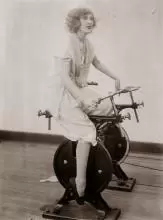A Walk on the Mild Side

We fellow Arts and Crafts enthusiasts have often been accused — and rightly so – of fostering a severe case of tunnel vision. We have to remind ourselves that the Arts and Crafts movement encompassed more than just hand-craftsmanship. Early proponents also advocated healthy lifestyles, wise choices in what we eat, and physical fitness.
In East Aurora, Elbert Hubbard led his staff in calisthenics on the lawn in front of the Roycroft Copper Shop. Frank Lloyd Wright took his Taliesin apprentices swimming in the nearby Wisconsin River. At the Grove Park Inn, Fred Seely scheduled daily hikes up Sunset Mountain (middle photo), and urged his guests to eat fresh prunes with every meal.
Okay, so that’s where I draw the line….
But nearly all of us are at the point in our lives where we are carrying around a few more pounds than we want (or that our heart needs), yet we don’t feel like joining a gym, running until our joints hurt, or hiring a personal trainer.
At least I don’t.
So, last May I started walking. (Pause and imagine an older, slower Forrest Gump.) And the more I walked, the better I felt. And the better I felt, the better I ate — and began paying attention to what I had been eating, like candy bars, hash browns, French fries, sausage, pizza, and greasy hamburgers. And without going on a fad diet, without setting foot in a gym, without biking, swimming, or running a single step, I started dropping the pounds.

It took a few weeks of experimentation to figure out what works for me, so maybe this can make it easier for you to give it a try.
First, do an online search for a couple of websites that will help you determine how many calories your body typically burns in a day. Lets say it’s 2500. Think of those as “credits” you start with each day. Consume fewer than 2500 calories, and you lose weight today. Consume more, and you gain weight. Some people like to make it more complicated, but it all boils down to this simple formula:
Calories in versus calories burned.
Second, use brisk walking to add credits to your daily burn amount. Brisk walking consumes as many as 100 calories per mile. A beginning walker can cover three miles in just one hour (300 calories), so, in our example, this way you can increase your daily calorie credits to 2800.
Third, pay attention to approximately how many calories are in what you eat. A banana or apple are both around 100 (with no fat!). A plain baked potato contains 150 calories and tastes just fine. Load it up with butter and sour cream and it hits nearly 500 calories — and clogs your arteries with deadly fat.
Fourth, do the math. A body typically requires a minimum of around 1500 daily calories just for your vital organs to function. Lets say you walk an hour each day, so in our example you now have 2800 calorie credits. If you stay around the 1500 minimum calories for your daily intake, you will have burned off around 1300 calories more than you consumed – which is a third of a pound of body fat.
By the end of the week, you can easily burn off 2 pounds.
By the end of the month, 8 pounds.
And in just three months: 24 pounds.
Without some fad diet or expensive membership.
Quick Tip: The two best hours of the day for walking are the first and last hours of light. Most people are either in bed, in front of their laptop or television set, or — worse yet — all three.
Put on your walking shoes and feel better !

Until next Monday,
Make something happen — for you!
Bruce
Top Photo Courtesy of www.HistoryInPhotos.com
Lower Photo Courtesy of www.Vintag.es.com
